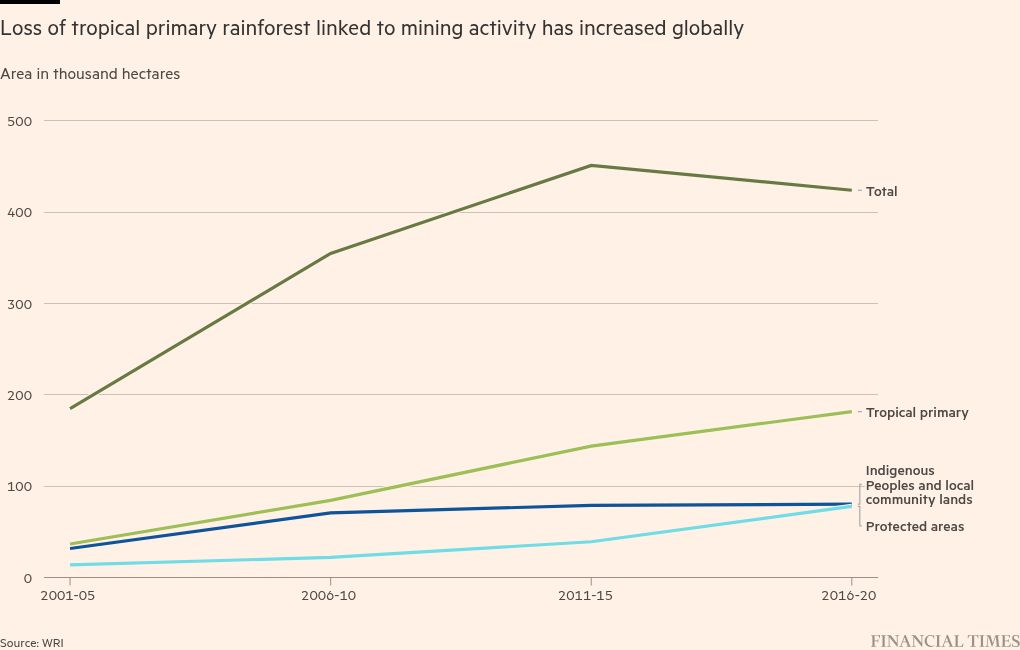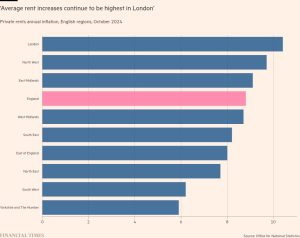Mining eats into more of the world’s forests

Unlock the Editor’s Digest for free
Roula Khalaf, Editor of the FT, selects her favourite stories in this weekly newsletter.
Mining continues to be linked to deforestation around the world as steel, coal, gold and critical mineral extraction projects all eat into the forests that act as vital carbon sinks and limit climate change.
Nearly 1.4mn ha of tree cover was lost between 2001 and 2020 in areas where mining and related activities have taken place, analysis of University of Maryland data by the non-profit World Resources Institute has found. This is an area roughly the size of greater Los Angeles.
Representatives of almost 200 countries have been gathering at a UN COP16 biodiversity conference in Colombia for the past two weeks to attempt to make good on a landmark agreement they struck in Canada two years ago.
This outlined a set of goals that included halting the extinction of species, protecting 30 per cent of the planet’s land and water ecosystems, and raising $200bn a year for nature by the end of the decade.
The deforestation trend was particularly concentrated in top mining countries including Indonesia, Brazil and Russia, WRI found. Mining drives less deforestation than the timber industry and wildfires, but is prevalent in tropical forest areas and in land earmarked for indigenous communities.
Private finance has played a stronger role in pushing companies to minimise both climate and nature risks in recent years, with banks such as HSBC introducing “no-deforestation” policies for clients including miners and agricultural commodity traders.
But the mining of critical minerals, such as copper, lithium, nickel, cobalt and rare earth elements, has been surging as these commodities are necessary in clean energy technologies including batteries, electric vehicles and wind turbines.
Marisa Drew, chief sustainability officer at Standard Chartered, said there were trade-offs in the shift to electrification and mining these metals and minerals.
“All infrastructure projects are a trade off . . . The world has got to reconcile with how do we service the enormous desire for electrification with the implications of that,” Drew said.

Mineral demand for clean energy technologies would need to quadruple by the end of the decade to meet climate targets, the International Energy Agency reported in 2021. Some of this could be tempered by reduction and reuse strategies, the IEA added in a report this month.
At the same time, the first comprehensive global assessment of the world’s trees, published during the biodiversity conference earlier this week, found that more than one in three species are threatened with extinction.
The International Union for the Conservation of Nature, a leading scientific authority, said that the loss has been driven by human deforestation but also by the effects of climate change, such as sea level rises and storms.
This could leave land more prone to flooding, and have knock-on effects for the animals, fungi and plants that rely on trees to prosper.
“Thriving, naturally diverse forests are essential in mitigating both climate change and biodiversity loss,” said Dave Hole, of Conservation International’s Moore Center for Science. “As such, solutions for one crisis often have mutually reinforcing benefits for the other.”
Climate Capital

Where climate change meets business, markets and politics. Explore the FT’s coverage here.
Are you curious about the FT’s environmental sustainability commitments? Find out more about our science-based targets here
#Mining #eats #worlds #forests







